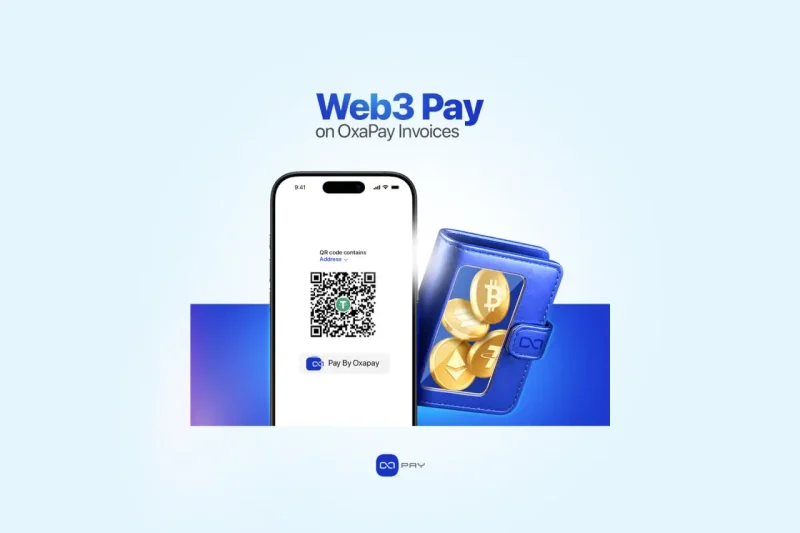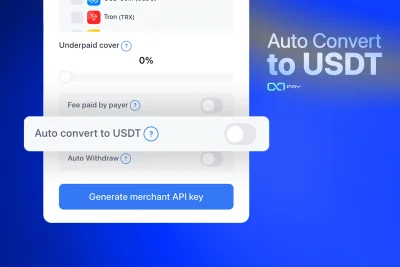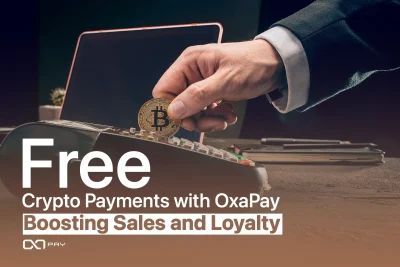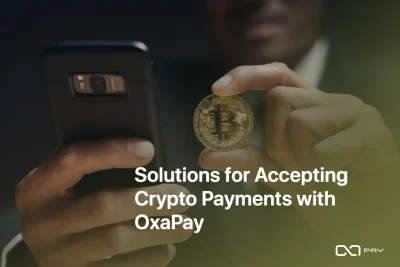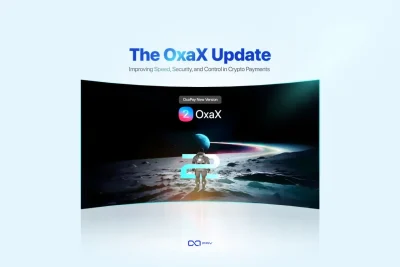Paying crypto invoices often means copying long addresses, scanning QR codes, and double-checking networks, steps that can easily confuse customers and cause failed transactions. To remove these barriers, the OxaPay crypto gateway has introduced Web3 Pay on Invoices, a feature that lets users connect their wallets and confirm payments instantly. With support for all major EVM networks, as well as Bitcoin, Solana, Tron, and Toncoin, this upgrade transforms invoice payments into a faster, safer, and truly seamless experience.
What Is Web3 Pay on OxaPay Invoices?
In OxaPay’s invoicing system, Web3 Pay allows users to pay directly with their wallets, whether it’s popular EVM-compatible options like MetaMask or Trust Wallet, or non-EVM wallets such as Phantom for Solana, Tonkeeper for Toncoin, TronLink for Tron, and others that support Bitcoin via WalletConnect. Instead of manually entering or copying a wallet address, users simply connect their wallet to the OxaPay invoice page, confirm the payment, and complete the transaction with a single click.
This approach eliminates manual errors and provides an intuitive checkout experience that aligns with modern Web3 standards. More importantly, it extends beyond EVM, giving customers flexibility to pay with leading blockchains like Bitcoin, Solana, Tron, and Toncoin, making it a major step forward in bridging usability and blockchain payments.
WalletConnect: A Simple Explanation
WalletConnect is an open protocol that lets users connect their crypto wallets to websites, apps, and services in a secure way. Instead of copying addresses or entering private keys, the wallet and the application communicate directly through an encrypted channel.
When a user chooses to pay or sign something, WalletConnect creates a secure “handshake” between the wallet and the app. The wallet shows the details, the user approves, and the transaction is completed, without ever sharing sensitive information.
This makes WalletConnect a universal bridge: it works with many wallets and supports multiple blockchains, making crypto interactions easier and safer for both developers and end users.
Understanding EVM Networks
The term EVM stands for Ethereum Virtual Machine, the technology that powers Ethereum and many other blockchains built to be compatible with it. For example, networks like BNB Chain, Polygon, and Base qualify as EVM-compatible because they follow the same standards and run the same smart contracts as Ethereum.
For payments, this compatibility is extremely valuable. It means that wallets supporting Ethereum can also work seamlessly on other EVM networks. As a result, Web3 Pay users can pay invoices on different chains using the same familiar wallet, without learning new tools or switching platforms.
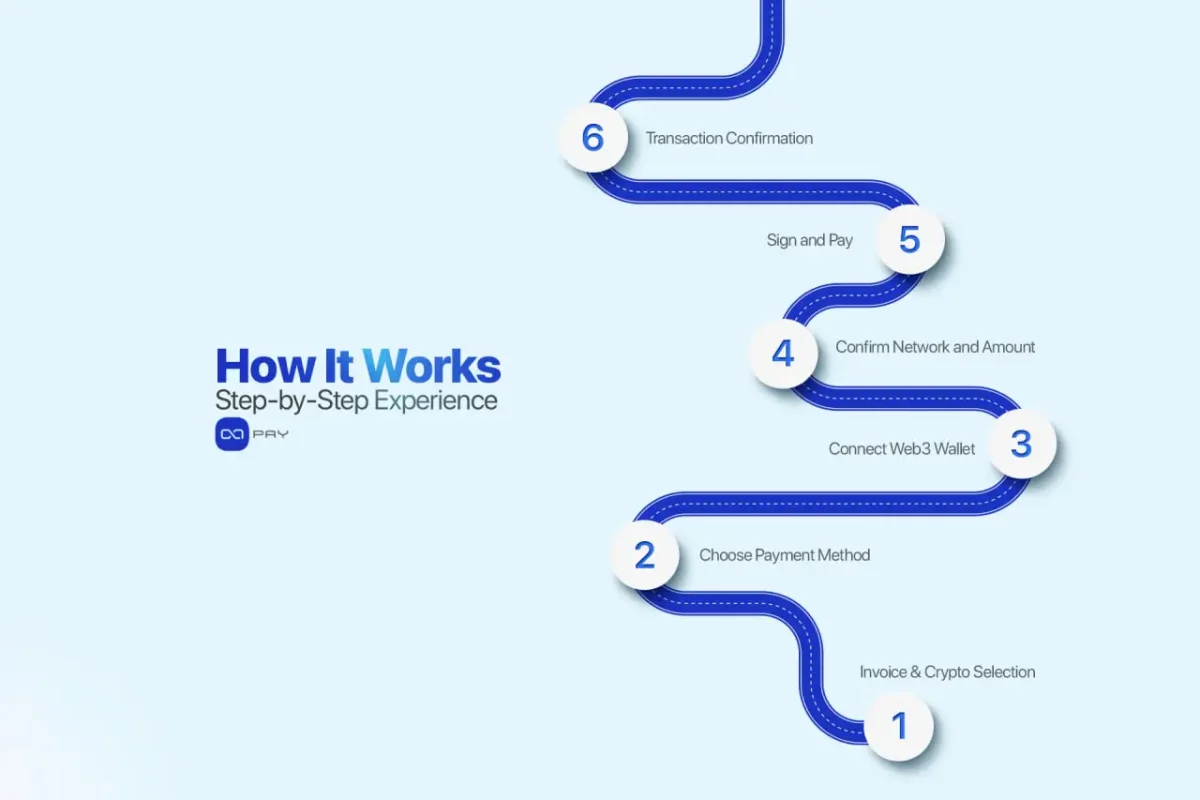
How It Works: Step-by-Step Experience
To better understand the customer journey, let’s walk through the process of paying an OxaPay invoice. The system provides multiple options depending on whether the customer wants to use their OxaPay Wallet balance or connect an external Web3 wallet.
1. Receive Invoice and Select Cryptocurrency
The customer receives an invoice generated by the merchant via OxaPay. It shows the amount due, expiration timer, and supported payment methods. At this stage, the customer also selects the cryptocurrency they want to use for the payment.
2. Choose Payment Method
On the payment page, the system clearly presents the customer with several options:
- Pay by OxaPay – for users who already hold funds in their OxaPay Wallet. However, this option follows a different flow, and another section explains it in detail.
- Trust Wallet, Phantom, Tonkeeper, TronLink, or other Web3 wallets – for users who prefer to connect an external wallet, whether EVM-compatible or non-EVM (e.g., Bitcoin, Solana, Tron, or Toncoin).
3. Connect Web3 Wallet (if selected)
When the customer chooses Trust Wallet, Phantom, Tonkeeper, TronLink, or another supported Web3 wallet, they simply connect it directly to the OxaPay invoice page. This connection works across both EVM networks and non-EVM chains like Bitcoin, Solana, Tron, and Toncoin, ensuring a smooth and consistent payment experience.
4. Confirm Network and Amount
Once the wallet connects, OxaPay automatically detects the balance and displays the required amount in the correct cryptocurrency and network. For example, when the invoice requires payment in Ethereum on the Base network, the interface clearly shows this information.
5. Sign and Pay
The customer confirms the transaction within their connected wallet. With a single sign, the customer authorizes the payment, and the system instantly transfers the funds to the merchant’s account.
6. Transaction Confirmation
The invoice page updates in real time to reflect the successful payment. Both the merchant and the customer see the confirmation immediately without manually checking transaction hashes.
Pay by OxaPay: Direct Payments from Your Wallet Balance
In addition to Web3 Pay, OxaPay invoices also include a Pay by OxaPay option. Instead of connecting an external wallet, users who already hold funds in their OxaPay Wallet can choose this method. Once they select it, the system instantly deducts the amount from their balance and completes the payment without extra steps. To use Pay by OxaPay, users must either stay logged into their OxaPay account in the same browser or log in when prompted. Then, the system immediately processes the payment from the OxaPay Wallet balance.
Supported Networks for Web3 Pay
Web3 Pay on OxaPay works through WalletConnect, which means it can operate across multiple blockchains that support this standard. In practice, this includes not only all major EVM-compatible networks, such as Ethereum, BNB Chain, Polygon, Base, and others, but also leading non-EVM blockchains like Bitcoin, Solana, Tron, and Toncoin.
However, technical compatibility does not mean every blockchain is automatically supported. OxaPay only processes payments made with its officially approved cryptocurrencies and networks. Each invoice clearly displays the available coins and networks for that transaction, so customers always know which option to use.
For the complete and regularly updated list of supported coins and blockchains, please visit the Supported Coins and Blockchains page.
Security Considerations
When introducing new payment methods, security is paramount. Here’s how OxaPay ensures Web3 Pay remains secure:
- One-Time Authorization: The customer signs a payment transaction only for the specific invoice. This is not an unlimited approval; OxaPay cannot pull funds repeatedly.
- Network Validation: OxaPay ensures that payments are always made on the correct network, whether Ethereum, another EVM chain, Bitcoin, Solana, Tron, or Toncoin. If the wrong network or currency is chosen, the system blocks the payment and prevents accidental losses.
- Real-Time Balance Check: Before processing, OxaPay checks the connected wallet’s balance across supported networks and notifies the customer if funds are insufficient, helping avoid failed payments.
- End-to-End Transparency: Customers see exactly how much they are paying, on which network, and where the funds are going. This clarity applies across all supported blockchains.
This design balances convenience with security, offering both merchants and customers peace of mind.
🔑 Important Note: One-Time Access Only
When customers pay with Web3 Pay, the signature applies only to that specific transaction. OxaPay never requests unlimited approval, and it cannot pull funds from the wallet again without a new signature. This design ensures that merchants receive the payment while customers keep full control of their wallets at all times.
Why Web3 Pay Matters
1. Frictionless Experience
Copying and pasting wallet addresses is one of the most common pain points for crypto users. A single wrong character can result in irreversible loss of funds. By eliminating manual entry, Web3 Pay minimizes this risk.
2. Mobile-Friendly
Since most Web3 wallets run on mobile devices, users can connect their wallet and confirm the payment much faster than they would with traditional QR scanning. This aligns with how most users interact with crypto today.
3. Conversion Boost for Merchants
Every extra step in the checkout process increases the likelihood of payment abandonment. Web3 Pay streamlines the process, making it more likely that customers will complete their payments successfully.
4. Multi-Chain Flexibility
Supporting all major EVM networks, as well as Bitcoin, Solana, Tron, and Toncoin, means merchants don’t need to restrict their customers to a single chain. This flexibility directly increases accessibility.
5. Future-Proofing Payments
Moreover, Web3 Pay aligns with the broader trend of Web3 adoption. As decentralized apps and services grow, having Web3-native payment methods becomes a competitive advantage for any business.
Web3 Pay vs Traditional Methods
To better illustrate the advantages, let’s compare Web3 Pay with the traditional payment process used in crypto invoices:
Traditional Process
- Copy address from invoice
- Open wallet app
- Paste address
- Enter amount manually
- Double-check network
- Sign transaction
- Return to invoice page and wait for confirmation
Web3 Pay Process
- Connect wallet
- Confirm amount and network
- Sign once to pay
By removing unnecessary steps, Web3 Pay saves time and reduces errors. For businesses, this translates into smoother operations and fewer customer support requests.
Benefits for Businesses
From a merchant’s perspective, adopting Web3 Pay provides several practical advantages:
- Higher Conversion Rates – With fewer steps, more customers complete their payments.
- Reduced Support Tickets – As a result, OxaPay minimizes mistakes such as “I sent to the wrong address” or “I used the wrong network.”
- Professional Image – Offering Web3-native checkout options shows customers that the business is modern and forward-thinking.
- Faster Settlement – OxaPay confirms payments instantly on-chain, and merchants can therefore access their funds without delay.
- Global Reach – Supporting multiple networks ensures customers worldwide can pay in their preferred way.
Benefits for Customers
Customers also gain tangible benefits from Web3 Pay:
- Convenience – No need to copy/paste or scan QR codes.
- Reduced Risk – Lower chance of human error leading to loss of funds.
- Control – Customers confirm the transaction directly in their trusted wallet.
- Choice – Flexibility to choose between different EVM networks.
Whether on Ethereum, Bitcoin, or Solana, Web3 Pay removes unnecessary steps, saving time and reducing errors. For businesses, this translates into smoother operations and fewer customer support requests.
Conclusion
Web3 Pay on OxaPay invoices makes crypto payments faster, easier, and safer. By supporting all major EVM networks along with Bitcoin, Solana, Tron, and Toncoin, and offering simple wallet integration, it reduces errors, boosts convenience, and builds trust. Both merchants and customers benefit from a seamless experience that brings crypto payments much closer to traditional online transactions.
Start accepting seamless Web3 payments today with the OxaPay crypto gateway and give your customers the modern checkout experience they expect.
